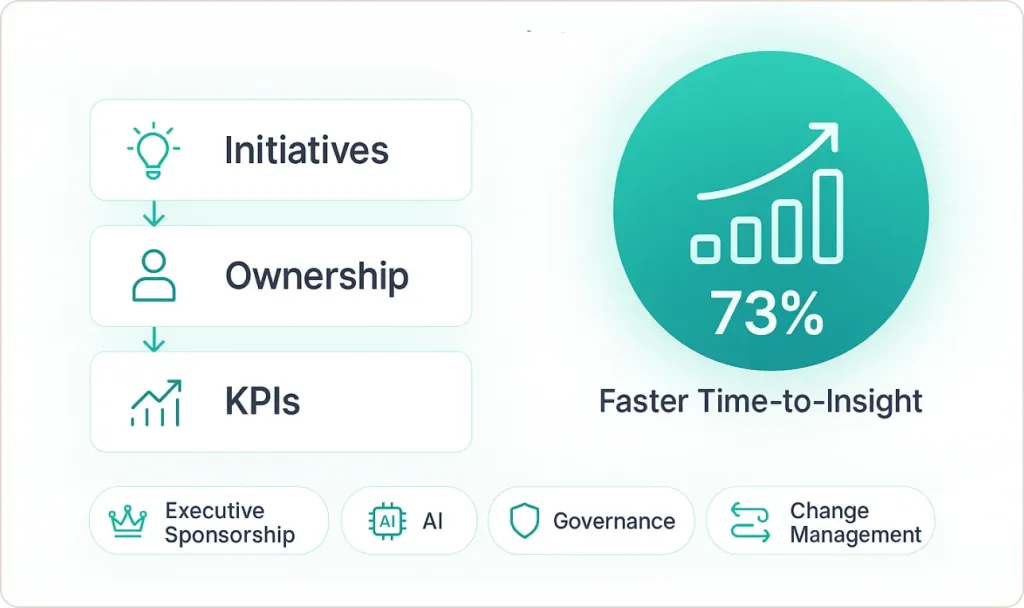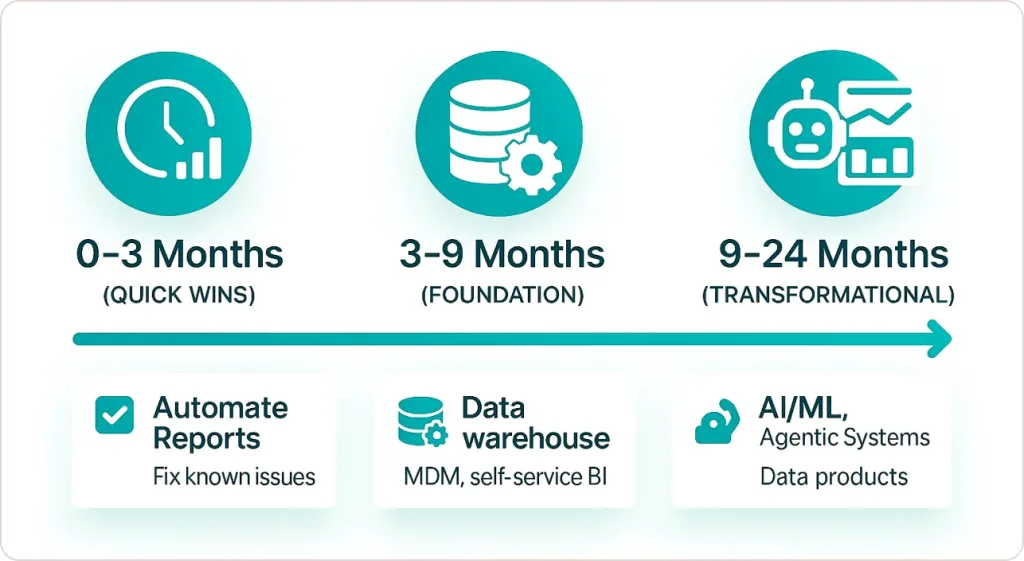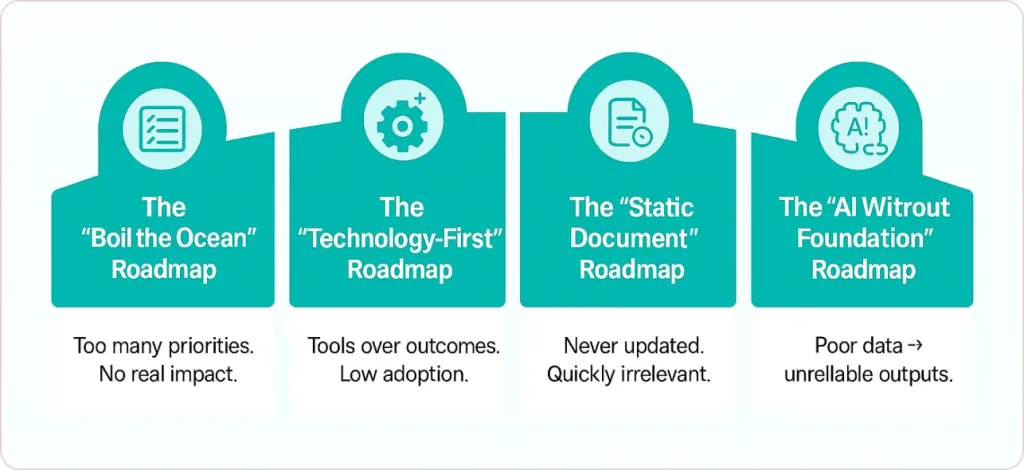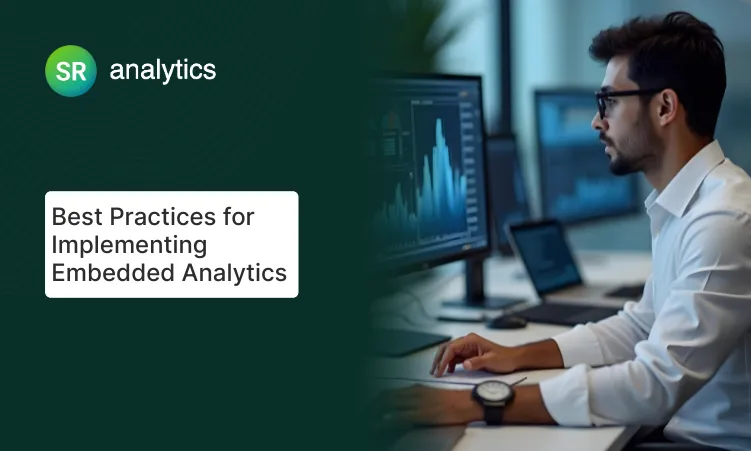TL;DR:
- A data strategy roadmap translates vision into time-sequenced execution with specific initiatives, deliverables, and business outcomes measured through both progress and outcome metrics
- Successful roadmaps balance quick wins (0-3 months) with foundational capabilities (3-9 months) and transformational projects including AI (9-24 months)
- AI initiatives in 2025 require quality data foundations first where 94% of leaders focus on data strategy due to AI interest, yet only 2% achieve high AI performance
- Adoption depends on executive sponsorship, tailored communication, celebration of early wins, comprehensive training, and quarterly reviews to maintain relevance
- Governance must be foundational with 15% of analytics budget allocated to quality and stewardship, clear data ownership, and decision-making structures that enable speed
I’ve spent over a decade working with data leaders, and I’ve seen the same pattern repeat. Companies invest millions in analytics platforms, hire talented data scientists, and set ambitious AI goals. Two years later, executives still make gut-feel decisions, analysts drown in ad-hoc requests, and expensive data warehouses sit underutilized.
What’s missing isn’t the technology, talent, or AI models. It’s the data strategy roadmap that bridges strategy to execution and ensures people actually use what you build.
Quick Answer:
A data strategy roadmap maps data initiatives to business objectives with clear timelines, ownership, and KPIs. Organizations using structured roadmaps achieve 73% faster time-to-insight. Success requires executive sponsorship, AI integration, governance frameworks, and change management to drive organization-wide adoption.

What Exactly Is a Data Strategy Roadmap in the AI Era (and Why Most Still Fail)?
A data strategy roadmap is more than a glorified project plan. It’s a strategic blueprint that sequences your data and AI initiatives across time, aligning them with business priorities while managing dependencies, resources, and organizational readiness for both traditional analytics and AI-powered decision-making.
A data strategy roadmap is a strategic blueprint that sequences data initiatives across time, aligning them with business priorities while managing dependencies, resources, and organizational readiness. It answers three critical questions: What are we building? When will it deliver value? Why does it matter to the business? And critically in 2025 does it create the foundation needed for AI success?
Most organizations create beautiful strategy documents that sit in SharePoint, never seen again. I watched one Fortune 500 company spend six months developing a comprehensive data strategy. Three months after rollout, department heads still built Excel-based systems because they didn’t understand how the strategy affected their daily work.
The data roadmap that gets adopted speaks the language of business outcomes, not technical architecture. It shows quick wins alongside transformational projects and includes change management from day one.
The 2025 Context: AI Changes Everything
Here’s what changed in 2025: 94% of data and AI leaders report that interest in AI is leading to greater focus on data strategy. Yet only 2% of organizations rate their AI performance highly in delivering measurable business results.
The gap? AI initiatives fail without quality data foundations. Your data strategy roadmap must now account for AI readiness alongside traditional analytics. This means addressing unstructured data management for multimodal AI, establishing governance for AI model outputs, and sequencing AI initiatives after foundational data quality work.
Organizations are discovering that agentic AI systems require unified data foundations free from silos. Your roadmap must prioritize these foundations before rushing to implement GenAI capabilities.
The organizations that thrive treat their data roadmap as a strategic communication tool. The CMO sees how customer analytics improves campaign performance. Operations understands when supply chain dashboards arrive. Finance knows which initiatives drive cost reduction.
Looking to assess your AI readiness? Explore our guide on how to use AI for data analytics to understand modern implementation frameworks.
Step 1: Set Your North Star Vision and Connect to Business Objectives
Every successful data strategy roadmap starts with clarity on business outcomes, not technical capabilities. Define success as “reducing financial close time from 10 days to 3 days,” not “implementing a modern data warehouse.”
Start by facilitating workshops with executives and business leaders. Understand their top three business objectives and the decisions they need data to support. What keeps them up at night? Where are they flying blind? What competitive advantages could better data create?
Translate business needs into 3-5 strategic data objectives framed as measurable outcomes. Instead of “improve data quality,” write “reduce customer record errors from 15% to under 3%, enabling reliable marketing segmentation.” Instead of “democratize data,” specify “enable 200+ business users to self-serve standard reports without IT tickets, reducing analyst workload by 40%.”
These objectives become your roadmap’s backbone. Every initiative must directly support at least one strategic objective. If you can’t draw a clear line from a project to business value, question whether it belongs in your data roadmap.
AI Integration Point: If AI initiatives appear in business objectives, explicitly map which data quality and governance foundations they require. An AI project lacking quality data will fail regardless of model sophistication. Our comprehensive AI in CPG guide shows how leading companies sequence AI readiness.
Establish clear KPIs for each objective. How will you measure success? What baseline metrics exist today? What does “good” look like in 12 months? These answers shape your entire data analytics strategy roadmap.
Step 2: Conduct a Brutally Honest Current State Assessment
You cannot map a journey without knowing your starting point. Your current state assessment should cover four critical areas.
Assessing Data Maturity Levels
Catalog your data landscape: what sources exist, where data lives, how systems connect, and what quality issues plague different datasets. Organizations typically have 2-3 times more data sources than anyone realizes, with shocking amounts of duplicate or conflicting information.
Assess data maturity honestly. Use frameworks like basic, intermediate, or advanced maturity levels across different business functions. Marketing might be advanced while operations remain basic. This granular view prevents one-size-fits-all solutions.
For a comprehensive understanding of how to benchmark your capabilities, check out our data analytics consulting services overview which includes maturity assessment frameworks.
Understanding Technical Debt
Evaluate your technical infrastructure’s readiness. Can current systems scale? Do you have cloud capabilities or aging on-premise architecture? What technical debt needs addressing before building new capabilities?
Assess organizational readiness for change. You might have perfect technology plans, but if your culture resists data-driven decisions, if leaders don’t trust analytics, or if analysts lack authority to influence decisions, your data strategy roadmap will struggle.
Document findings with specific examples and metrics. “Data quality issues” becomes “Customer master data has 18% duplicate records, causing $2.3M in misdirected marketing spend annually.” Specificity drives urgency and helps prioritize initiatives.
Step 3: Build Governance Into Your Foundation
Here’s an uncomfortable truth: governance isn’t sexy, but it’s the difference between roadmaps that succeed and those that create expensive chaos.
I’ve watched organizations rush to build analytics dashboards while ignoring basic questions like “Who owns this data?” The result is always the same: initial enthusiasm gives way to confusion, distrust grows as numbers conflict, and people revert to old systems.
Current best practices recommend allocating at least 15% of analytics budget to data quality and stewardship. Your data governance strategy and roadmap needs three layers.

Data Ownership and Stewardship
Establish clear data ownership. Every critical data domain (customers, products, financials, operations) needs an accountable owner from the business side, not IT. These owners make decisions about definitions, quality standards, and access policies.
Data Policies and Standards
Define data policies explicitly. What quality thresholds must data meet? How do you handle personally identifiable information? What approval process governs new data integration? For U.S. organizations, this includes CCPA, HIPAA compliance where applicable, and industry-specific requirements.
Decision-Making Structures
Create decision-making structures that work at organizational speed. I recommend a tiered model: a data governance council for strategic decisions (monthly, executive level), domain steward groups for operational standards (bi-weekly, working level), and clear escalation paths when conflicts arise.
Governance enables speed rather than slowing things down. When everyone knows who decides what, when definitions are standardized, and when quality standards are clear, projects move faster.
Step 4: Prioritize Ruthlessly Using Impact and Effort
This is where strategy becomes real. You likely have 50 potential data initiatives but resources for 8-10 in the next year. How do you choose?
Use an impact-effort matrix considering three dimensions: business value (revenue impact, cost savings, risk reduction), technical complexity, and organizational readiness. The sweet spot is high business value initiatives with moderate technical complexity where the organization is ready for change.
Quick Wins (0-3 months)
Identify 2-3 quick wins deliverable in the first quarter. These build credibility and momentum. Maybe it’s automating a painful manual report taking analysts 10 hours weekly or fixing a known data quality issue frustrating executives.
Want to see quick wins in action? Our Awe Inspired case study shows how custom dashboards delivered immediate business impact within 90 days.
Foundation Building (3-9 months)
Focus on foundational capabilities that enable multiple use cases. This might be implementing your data warehouse, establishing master data management, or creating your first self-service analytics environment. These initiatives take longer but unlock significant downstream value.
Discover how we helped Pinnacle Fund Services build foundational reporting capabilities in our comprehensive reporting solution case study.
Transformational Projects (9-24 months)
Include transformational projects like advanced analytics, AI/ML capabilities, or comprehensive data products. In 2025, this increasingly means agentic AI systems requiring the governance, quality, and architectural foundations you’re building in earlier phases.

Explicitly plan technical debt reduction into your data roadmap. If you’re carrying significant legacy systems, allocate 15-20% of capacity to addressing these. Otherwise, they’ll cripple your ability to deliver new capabilities.
Step 5: Create Your Visual Roadmap That Stakeholders Understand
The roadmap document itself matters enormously. Your data strategy roadmap template should be a single-page visual someone can grasp in 60 seconds.
Organised as a quarterly timeline showing initiatives across key capability areas: data architecture, governance, analytics and BI, AI and advanced analytics, and data culture and skills.
Each initiative includes four elements: a clear name indicating business value, the primary business objective it supports, key deliverables or milestones, and the executive sponsor or business owner. Instead of “Implement Snowflake,” write “Customer 360 Database (Sponsor: VP Marketing) to enable real-time campaign optimization.”
Use color-coding to show initiative status and dependencies. This visual clarity helps executives immediately see what’s in flight, what’s coming next, and how different workstreams relate.
The data roadmap should indicate resource requirements at a high level. How many FTEs does each major initiative require? What skills are needed? If you’re showing five parallel initiatives but only have two data engineers, stakeholders need to understand those constraints.
Create two versions: an executive summary roadmap (one page, high-level) and a detailed roadmap (3-4 pages) including technical specifics, dependencies, and risk factors for the working team.
Learn best practices for creating compelling data visualizations in our guide on how data visualization improves decision-making.
Step 6: Plan Resources and Technology With Realistic Constraints
Your data strategy roadmap is only as credible as your resource plan. Map skills required for planned initiatives: data engineers (building pipelines and infrastructure), analytics engineers (modeling data for business use), BI developers (creating dashboards), data scientists (building predictive models), and data product managers who connect technical work to business needs.
For each major initiative, estimate effort required and identify who will do the work. Be honest about capacity. If your team is fully utilized on maintenance, you need to acquire resources, deprioritize work, or extend timelines.
Technology decisions should align with roadmap phases. If you’re planning customer analytics in quarter 2, you need your data warehouse operational in quarter 1. If advanced analytics is a year-two priority, ensure your architecture won’t preclude it.
Adopt a pragmatic technology approach. Use proven, enterprise-grade platforms for foundational capabilities. Cloud data warehouses like Snowflake or Google BigQuery provide needed scalability. For business intelligence, platforms like Power BI or Tableau offer both power and accessibility. Consider modern data lakehouse architectures and vector databases for AI/RAG applications.
Budget realism matters. Include not just technology licenses but implementation costs, training, and ongoing support. A $200K annual platform license often requires another $400K in services and internal labor to implement successfully.
Expert Insight
“The data strategies that succeed are the ones that earn executive trust by connecting every initiative to measurable business value. Your roadmap should answer one question: how will this help us win in the market?” – Analytics8 Principal Consultant (Analytics8 Blog)
Step 7: Obsess Over Change Management and Adoption
This separates data roadmaps that get adopted from those gathering dust. I’ve seen technically perfect implementations fail completely because nobody considered the people’s side until too late.
Building Your Data Champion Network
Change management begins with executive sponsorship. You need a C-level champion who actively advocates for the data strategy roadmap in leadership meetings, allocates resources, and holds business units accountable for adoption.
Training Strategies That Work
Develop a communication plan reaching every stakeholder group with tailored messages. Executives need strategic impact and ROI. Department managers want to know how this helps their teams. Frontline users care whether new tools make jobs easier or harder.
Monthly communication should celebrate progress, share success stories, and transparently address challenges. When the sales dashboard launches and reduces report preparation time from 3 hours to 15 minutes, make sure everyone hears about it.
Training cannot be an afterthought. For every new capability, plan comprehensive enablement including technical training on tools and education on asking good analytical questions and interpreting results.
Step 8: Establish Metrics and Commit to Quarterly Reviews
A data roadmap without measurement is wishful thinking. Organizations now distinguish between progress metrics (adoption levels) and outcome metrics (revenue impact) for comprehensive performance tracking.

Initiative-Level Metrics
Measure delivery against plan, budget versus actual, and quality of deliverables. Were milestones met? Did scope creep occur? What lessons inform future initiatives?
Capability Metrics (Progress)
Assess adoption and usage. How many users access new dashboards? What’s the trend in self-service analytics versus IT ticket requests? How has data quality improved in key domains?
Business Outcome Metrics
Connect back to strategic objectives from step one. If you aimed to reduce financial close time, what’s the current close cycle? If customer analytics was supposed to improve campaign ROI, what’s happening to marketing efficiency?
Schedule quarterly roadmap reviews as standing meetings with executive stakeholders. Walk through progress against plan, share key metrics, discuss challenges and adjustments, and preview next quarter’s priorities. Best practices recommend roadmaps spanning 12-18 months with quarterly reviews, though AI evolution may require more frequent updates.
Be prepared to adjust priorities based on learnings. Maybe a planned initiative is no longer relevant because business strategy shifted. Perhaps a quick win revealed a bigger opportunity. The data strategy roadmap should evolve with understanding, but changes should be deliberate and transparent.
Create a simple scorecard tracking overall roadmap health. What percentage of initiatives are on track versus delayed? Are you hitting adoption targets? What’s the aggregate business value delivered?
Learn how to build effective tracking dashboards in our guide on AI-powered data storytelling dashboards.
Common Data Strategy Roadmap Anti-Patterns to Avoid

The “Boil the Ocean” Roadmap
Trying to address every data challenge simultaneously. Result: resources spread too thin, nothing delivers meaningful value. Instead, ruthlessly prioritize and sequence initiatives.
The “Technology-First” Roadmap
Focusing on implementing cool tools rather than solving business problems. Result: expensive platforms with poor adoption. Always start with business outcomes.
The “Static Document” Roadmap
Creating a beautiful plan never updated after initial approval. Result: roadmap becomes irrelevant as business needs evolve. Commit to quarterly reviews.
The “AI Without Foundation” Roadmap
Rushing to GenAI implementation without addressing data quality and governance. Result: AI projects fail or produce unreliable outputs. Build foundations first.
For industry-specific examples of successful roadmap execution, explore our CPG analytics trends guide showing how leading brands sequence initiatives.
Moving Forward: Your Next Steps
Your data strategy roadmap isn’t about technology or technical architecture, though those matter. It’s about creating organizational alignment around how data will drive better decisions and business outcomes. It’s about sequencing work so each initiative builds on previous capabilities. And critically, it’s about change management that ensures people actually use what you build.
The organizations winning with data in 2025 aren’t necessarily the most technically sophisticated. They’re the ones with clear data roadmaps connecting analytics work to business priorities, communicating progress transparently, and celebrating wins while learning from setbacks.
If you’re ready to develop a data roadmap that actually gets adopted, start with stakeholder conversations this week. Understand their challenges and desired outcomes before drafting a single initiative. Build your data analytics strategy roadmap collaboratively rather than in isolation.
For more insights on emerging trends shaping data strategy, explore our comprehensive guide on business intelligence and analytics trends for 2025.














